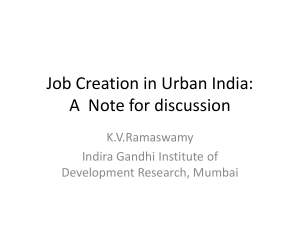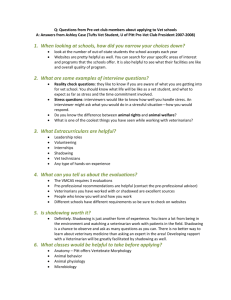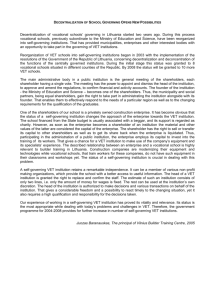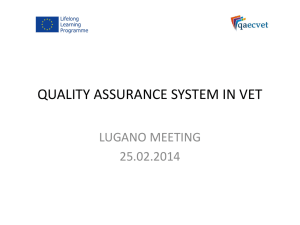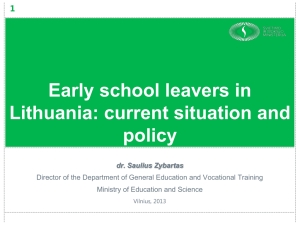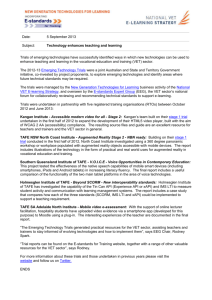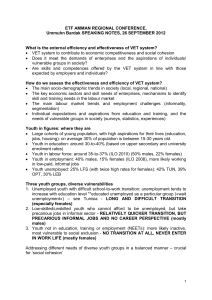Design of public policies for a productive and entrepreneurial
advertisement
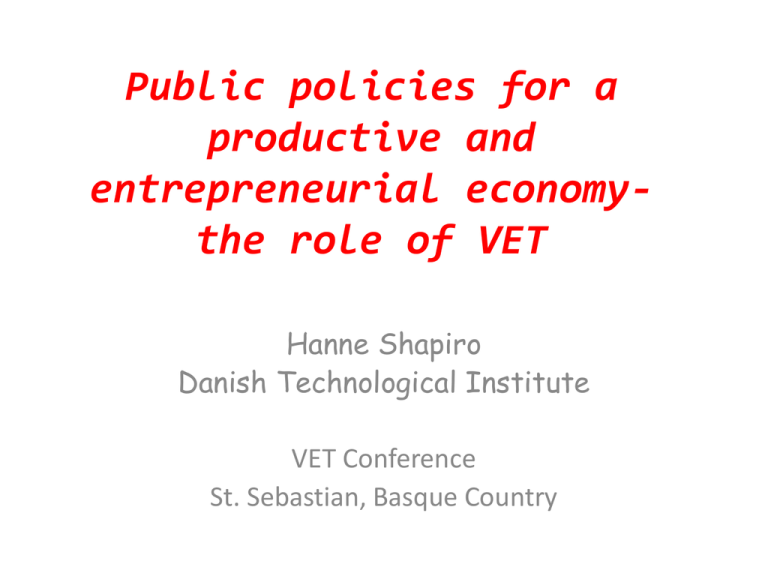
Public policies for a productive and entrepreneurial economythe role of VET Hanne Shapiro Danish Technological Institute VET Conference St. Sebastian, Basque Country Envisioning- Aligning Engaging Background- analysis • SME’s in global value chains- role of digital technologies • State of Affairs- Manufacturing industry EUEuropean Parliament • SME growth strategies- international best practice- design of Danish SME Growth Programme • PIAAC data- Adult Learning indicator- DG EAC • VET Excellence- VET and innovation- DG EAC • World Economic Forum- Work on Employment rich recovery- role of apprenticeship 7 Emerging issues • Biggest SME challenge in EU 28- lack of customer demand • Major changes in markets/ inclusive innovation as growth opportunity- OECD World Bank, World Economic Forum? • Limitations of skills supply policies – 7 Major Isssue emerging Cont • The role of VET in economic development and innovation? • Unrecognised role of the skilled worker in innovation in SMEs- DUI Innovation• But not all SMEs are set to exploit that opportunity • VET excellence? Opportunity space for SMEs • Multinationals concentrate number of SME suppliers – become partners in innovation • Digital technologies become a proxy for efficiency – and a means of cooperating across firm boundaries /( shared standards ) • Growing integration of products , components, systems and services- modularisation a means to meet diversified demand cost- effectively • Critical factor : capabilities at the shop floor level DUI Innovation – modularised products/services BIG policy question- implications on VET?????? • Digital taylorism to improve efficiency/ productivity in European SMEs or • The shop floor not a cost but a source of innovation (the role of the shop floor/ front line worker) Skills Utilisation • Efficient skills policies must address skills utilisation • Implication on VET systems: From training providers – to ?? • Numerous programmes aimed at enhancing the skills of the future existing workforce • Few programmes at scale that situate work organization , job redesign, technology utilisation and skills as a means of improving competitiveness Innovation : to orchestrate teaching and learning processesR&D driven innovation: investments, capacity, risks, costsproblems taking products to the innovation stage User and employee driven innovation as interactive and learning based models: doing, using, interacting Work organisation and leadership practices Employees tacit experiences Value added: products , services concepts Markets, customers, suppliers, other providers in the knowledge system? The enabling role of ICT- BUT? • In DK fx 1 mill Danes 16- 65 years who cannot solve basic problems in an ICT environment• Higher order numeracy- literacy: analysis, synthesis, envisoning/ simulation , understanding complex data problem shooting, problem identification • Emulating work environment+ New Skills New Jobs? Role of VET institutions • Skills utilisation could be part of the wider business support structure a VET institution offer • Horisontal and vertical cooperation within the innovation system- enabling policies? • Build capacity for better skills utilisation as part of a firm’s strategic planning (clusters, networks, value chain upgrading.) Work placed learning/ apprenticeships • Competence/ Learning outcomes- learning at school – learning at work as an integrated setting; ( dedicated school staff) • Learning- (knowledge, skills, and competences) - routinisation/ progression in complexity- • “the company’s hidden repository” • A learning environment that offers opportunities to reflect on practice/transcend practice- different communities of practices • Status and an employee- but also as a learner • Measures focusing on building employers’ capacity to host learners/ measures to adapt to the needs of the company; • Process and tools to support - reflective practice PROCESS-ORIENTED PEDAGOGIC MODEL LEARNER/ USER Scoping Performing or? 14 Technical, Methodological & Social Competencies Experimenting Envisioning/ CreatingE Work Placed Learning- Design for real use • Real-world relevance: Authentic activities match the real-world tasks of professionals in practice. mimicking “the professional practice.” • Ill-defined problems: ( wicket problems) Authentic activities are relatively undefined and open to multiple interpretations, requiring students to pose questions, experiment, and see a problem from different perspectives. • Design thinking ( role of simulations) • OER- the Wider community network- Open 21 st Century VET – Global value chain perspective Envisionment prioritisation what are the genuine local assets? Great global challengesrethinking manufacturing for solutions that matter Consider scale and mainstreaming from the outset Rethinking local assets ”Tinkering” for the real world( entepreneurial skills– technological skills, problem solving, design to cost, collaboration, entrepreneurial capcity- Innovation) The factory as a learning model – experimentation. Trial and error. Production Methaphor for learning OER- Source materials: producing artefacts for a real world- simulations Social Enterprise- rethinking public works Enabling factors Policy Aligningeconomic, labour market, ed Institutional autonomy- multidimensional accountability Strategic linkages and partnerships the local communityRecognition of prior learning Getting it right for everyone! Thanks Hanne ShapiroDanish Technological Institute- hsh@teknologisk .dk


